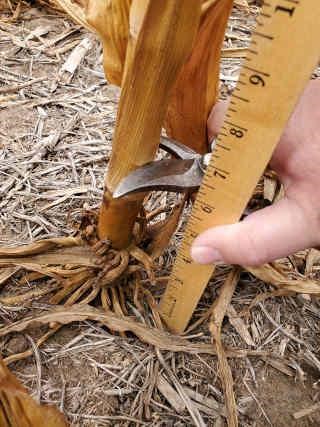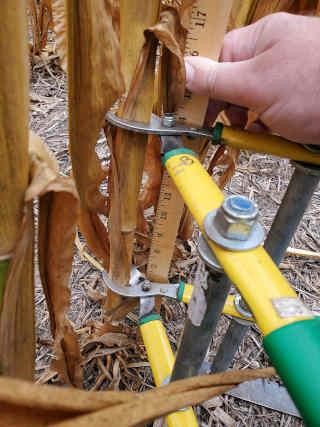By Jeremy Milander and Javed Iqbal et.al
Late-season cornstalk nitrate tests can be a valuable tool to help evaluate the efficiency of your nitrogen management program. One limitation of this test that is particularly relevant this growing season is that the test should not be used if moisture was a limiting factor. Under rainfed conditions during drought seasons, the test will be more indicative of water stress than nitrogen.
Nitrogen management is a dynamic process. You start with a specific nitrogen application plan, but as the season progresses, you adjust based on conditions in the field. At the end of the season, a nitrate test can help determine whether the crop was under-, adequately or over-fertilized with nitrogen.
The test should not be the only tool used to evaluate nitrogen management as knowledge of the field — management practices and the growing season are critical for interpreting results. The results of the test should also be interpreted with yield data when available.
The stalk nitrate test would be useful when doing a strip trial or comparison of two different nitrogen management practices. The test could also help to diagnose where to sample for carryover nitrates next spring. It is easier to sample the stalks, and if they are very high, that would indicate that probably is still nitrogen in the soil that could be utilized by future crops.
There are situations in addition to water-limiting circumstances in which the stalk nitrate test would not be effective for evaluating nitrogen. Other stresses such as disease, insect or weed pressure, hail or high winds may make it difficult to pinpoint if the results are truly reflective of plant nitrogen uptake.
The test is also more effective at detecting excess nitrogen, as deficiencies can be easily spotted visually by leaf yellowing. If the test comes back in the excess range, it would indicate that a reduction in the nitrogen rate might be possible next season; however, the results are best used as a tool when comparing trends from several years due to the unreliability of just one growing season’s data. One also needs to keep in mind that due to various factors, attaining optimal nitrate concentrations in all fields every year is unrealistic. (For more information on recommended rates, see the Nebraska Extension Nebguide, “Nutrient Management Suggestions for Corn” [EC117] or visit the CropWatch Soil Fertility page, where there is a recently updated nitrogen rate calculator and other resources to help with nitrogen management.)
Take cornstalk samples up to three weeks after black layer formation on 80% of the kernels. Published information indicates the stalk test can be taken as early as when the milk line is one-fourth of the way down the kernel. For silage corn, it is recommended to sample at the time of harvest or within 24 hours after harvest, as long as there is no rainfall between the time of harvest and sampling and the cutter bar has been raised to provide a 14-inch stalk height.

Figure 1. For a nitrate test, remove a segment of cornstalk from six to 14 inches above the ground. (Photo by Jeremy Milander)

Figure 2. Your sample should be an eight-inch segment of the cornstalk, with sheaths removed. (Photo by Jeremy Milander)
To take the test, remove an eight-inch segment of the stalk from six to 14 inches above the ground. Collect 15 samples from randomly selected stalks from about an acre area that is representative of a larger area. Keep in mind there is variability within fields and even within soil types, and this is likely to affect results. Sheaths should be removed from the stalks and diseased stalks or stalks damaged by hail or insects should not be collected. Separate samples should be taken for different soil types and management areas. Place samples in paper bags instead of plastic to allow the stalks to dry some and avoid mold. Samples should be shipped within 24 hours of sampling or refrigerated until shipped.
Table 1. Interpretation of the test results.| Plant nitrogen status | Stalk nitrate (ppm) | Interpretations |
|---|
| Low | <250 | Low: Adjust N management practices limiting N supply to the crop. |
| Sufficient | 250-2000 | Sufficient: Nitrogen was adequate for the conditions during the growing season. |
| High | >2000 | High: Excess N was available during the growing season, so consider reducing N rate next year. |
Source : unl.edu